NorthEast Radio Watch 12/8/2025: Cichon’s Back in Buffalo
In this week’s issue… Veteran newsman returns - Remembering NY's Leitner, RI's Jones - CT AM saved - Maine AM moves - "Indie" adds suburban signals
Text and photos by SCOTT FYBUSH
After our brief detour into current events with the demise last week of New York’s WPLJ, we resume this week in the midst of last fall’s circuit around Georgia and Florida. Specifically, we’re in the midst of a couple of busy days driving around Tampa Bay, our first visit to the market since 2011.
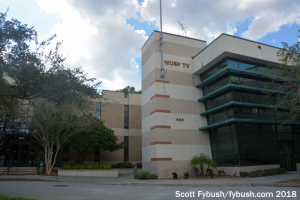
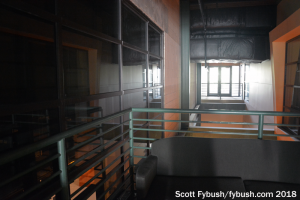
Back then, we saw a lot of transmitters and not so many studios; in September 2018, we reversed that pattern, spending most of our time adding new studio visits to our collection.
We start this week’s installment out on the northeast corner of the Tampa sprawl, up at the University of South Florida. Have any other universities added a radio station as speedily as USF did? Founded in 1956, the school put WUSF (89.7) on the air just seven years later, in 1963. (More remarkably, that was just three years after classes actually began there!)
In 1966, USF added WUSF-TV (Channel 16), a secondary public TV signal following in the path of WEDU (Channel 3), the area’s first educational broadcaster. And while the sign outside the building on campus still said “WUSF-TV” when we pulled up in 2018, it was a historical relic; USF had sold WUSF-TV’s spectrum at auction a year earlier, then donated its zombie license to WEDU. There was no more “16” on the Tampa TV dial, even virtually; instead, WEDU turned the old WUSF-TV license into WEDQ, virtual 3.4 on the WEDU transmitter.
The former TV studio here was dark, and the TV offices had mostly been vacated, with that side of the building set to be returned to the university for other uses.
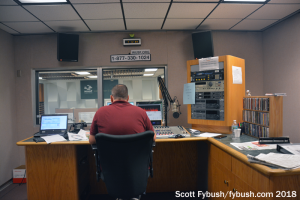

The radio side, however, has never been stronger. While WUSF’s TV operation was always the second banana in town, WUSF radio has always been the major public radio operator in Tampa. (Later on, it was joined by WMNF, a more freeform community listener-supported signal.)
Another big change came just a few years ago, when WUSF split its news and classical services. The big 89.7 Tampa signal went full-time news and information, sending classical to a combination of HD2 along with two analog FMs, WSMR 89.1 (a former religious station down to the south in Sarasota, with no really useful coverage in Tampa or St. Petersburg) and W280DW 103.9, a translator serving most of Tampa from a tower near the USF water tower, across campus from these studios. (No, I can’t explain why I didn’t go over there to get a picture.)
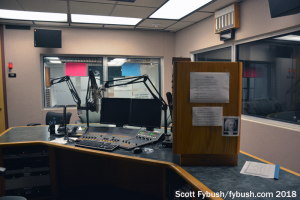
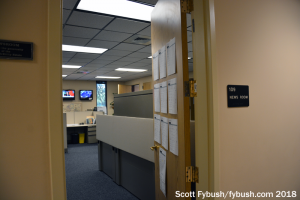
The WUSF studio spaces are tucked in the core of the radio side of this complex, with several control rooms and talk studios surrounding a rack room. (WSMR’s classical format is largely voicetracked, so its room didn’t have anyone in it when we stopped in.)
The main WUSF signal was in pledge drive mode, and when they do pledge here, they do it from the big double-height performance studio at the center of the building, where we’re able to look down at the pledge hosts (including one of our many New England radio friends who’s migrated south, news anchor Lisa Peakes) standing at the front of the studio, with the phone banks just behind them and a big wall of pledge numbers and information in front of them, looking into the rest of the radio studio complex.
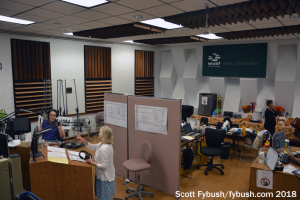
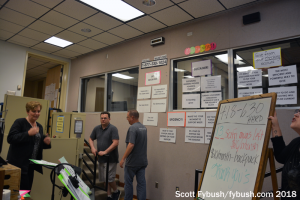
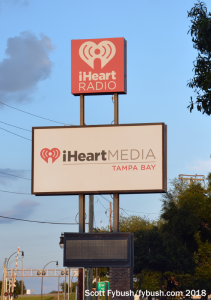
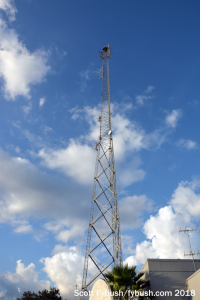
From WUSF, we fight late afternoon Tampa traffic (and there’s plenty of that!) as we head south and west to the opposite corner of the city.
Southwest of downtown, just north of MacDill Air Force Base, iHeart’s Tampa Bay cluster occupies a low-slung building on Gandy Boulevard just a few blocks east of the Gandy Causeway that stretches across the bay to St. Petersburg. (Yes, that’s the very causeway whose western end is spanned by the two towers of iHeart’s WDAE 620, which we saw back on the 2011 trip.)
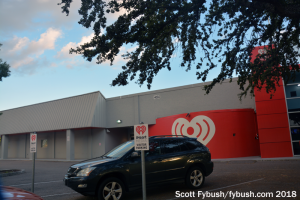
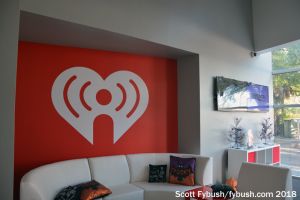
This low-slung building, as it turns out, was once a fitness club – but today, it’s home to nine radio stations and then some.
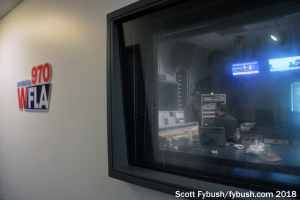
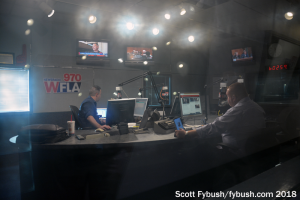
The first studios we peek into as we begin working our way back from the front lobby are busy with afternoon-drive talk: WFLA (970) is the market’s dominant news-talk station (and the progenitor of a bunch of iHeart “WFLA”-branded clones in other markets, including Orlando, Panama City and Tallahassee); down the hall, WDAE (620) is the market’s dominant sports talker and home of the Tampa Bay Rays.
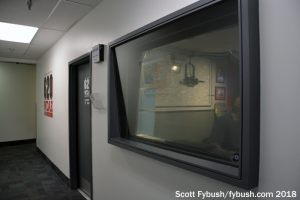
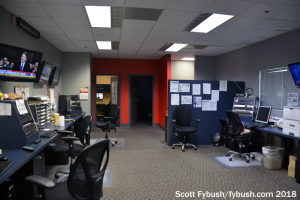
After a quick walk past the big AM stations’ studios and the WFLA newsroom, we see some of the shared facilities at the core of the building: a small office that’s been converted into a podcast studio, with lighting, a video screen and lots of options for quick video hits or more elaborate productions. Down the hall, a big space has been turned into the performance studio, with easy audience access from the lobby.
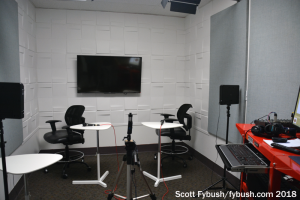

From here, we head into one of the two FM studio complexes in the building. These were some of the original studios here, and the first one we pass holds an important place in top-40 history. This big room on the west side of the building is home to WFLZ (93.3), now a fairly mainstream iHeart top 40 – but back in the 1990s, this was Jacor’s “Power Pig,” where Randy Michaels led one of the legendary radio wars against competitor WRBQ, eventually driving “Q105” out of the format entirely.
Look closely at the window that separates the main air studio from the smaller mix studio and you’ll still see a “Power Pig” window sticker, a permanent nod to that chapter in radio history.
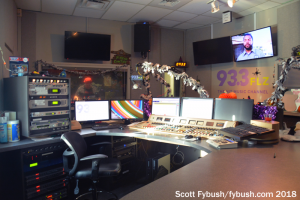
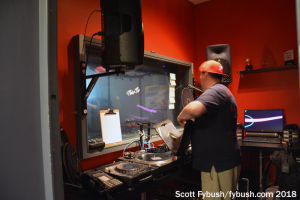
Across the hall is the smaller studio that’s home to the rhythmic outlet here, “Beat” WBTP (95.7); down the hall is a clone of the WFLZ studio, this one home to hot AC “Mix” WMTX (100.7).
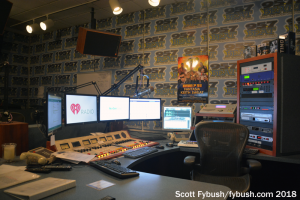
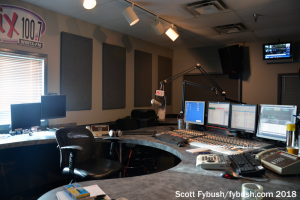
Because of the way this studio complex kept growing as Jacor/Clear Channel/iHeart kept adding stations to its original WFLA/WFLZ pair, the rack room is actually two separate rack rooms, the larger one built in what I’m told was the original weight room of the fitness club!
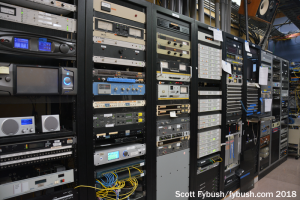
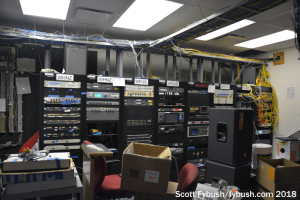
That second rack room, shown at right above, feeds the newer additions to the cluster, which have their own studios in an addition on the back.
“Rumba 106.5,” technically, isn’t even a Tampa-market station – this is Spanish hits WRUB (106.5 Sarasota), which rimshots Tampa Bay from the south, but which the FCC considers to be part of iHeart’s separate Sarasota-market cluster, even though the studios are up here in Tampa.
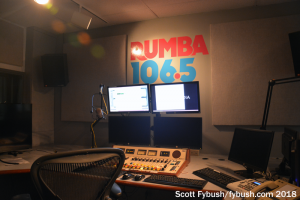
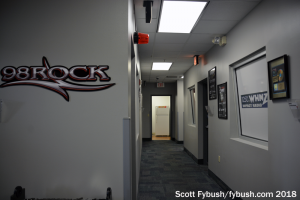
The studios out back here hold some of the more recent additions to the cluster. WHNZ (1250) came out of the old Lowell Paxson radio group by way of a big shuffle of calls and frequencies that moved the WHNZ calls from 570 up to the former WDAE at 1250; today, it’s a second-tier talker that’s probably best known in the market as the radio home of the Tampa Bay Lightning. Its live studio here is used mainly for weekend shows; it also doubles as a studio that visiting syndicated talk hosts can use on weekdays.
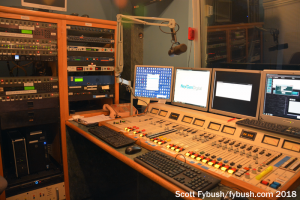
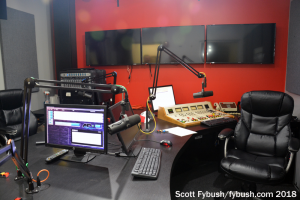
At the back corner of the newer studio hallway, WFUS (103.5) is the country station in the cluster, competing with Beasley’s WQYK. This signal is another move-in from Sarasota, and was for many years also the radio home of the Tampa Bay Buccaneers.
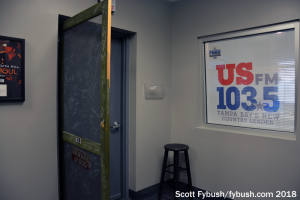
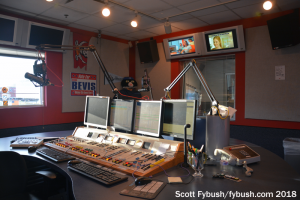
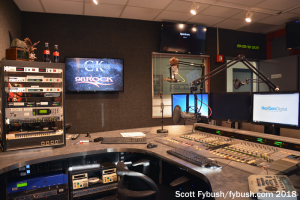
(And dig that old-fashioned decorative screen door in front of the main WFUS studio door!)
Finally back here, we find the spacious studio of “98 Rock,” WXTB (97.9). This Clearwater-licensed signal is the current Bucs flagship. It’s also the outlier among the iHeart FMs, transmitting from up north at the Holiday FM site instead of from the more central Riverview towers with WFLZ, WMTX and WFUS. (WBTP, also licensed to Clearwater, is even closer – it’s on a tower just across the Gandy Causeway in St. Petersburg.)
From these studios in the back of the building, we can see the STL tower out back that feeds all those FM sites as well as 620 just across the causeway and the 970/1250 diplexed site in Oldsmar, at the north end of the bay. Want to see the Riverview site? We did, too – and we’ll show that to you next week!
Thanks to Brett Holcomb and Drew Kelly for the tours!

As we announced a few weeks ago, the 2026 edition of the Tower Site Calendar will be the last.
We began publishing it 25 years ago, and the broadcast landscape is radically different now.
Radio World just ran an excellent article about us if you want to know more.
Once it’s gone, that’s it. We won’t be printing any more.
Thank you to everyone who saw our announcement and rushed to buy it. We appreciate you.
(There are some calendars from previous years if you want more of a tower photo fix — all under $5.)
But don’t wait to get this year’s Tower Site Calendar — buy it now!
We are selling the Broadcast Historian’s Calendar again this year, but we have that in an even smaller quantity — definitely don’t hesitate for that.
And visit the Fybush Media Store to check out our selection of books and videos, too!
And don’t miss a big batch of Tampa IDs next Wednesday, over at our sister site, TopHour.com!
Next week: Tampa’s Riverview tower farm, 2018
In this week’s issue… Veteran newsman returns - Remembering NY's Leitner, RI's Jones - CT AM saved - Maine AM moves - "Indie" adds suburban signals
In this week’s issue… Scripps stations face takeover - Sinclair moves more affiliations - CT stations sold - Maine AM surrendered - Remembering WVBR's Shapiro, WABC's Morgan
In this week’s issue… CT TV legend succumbs to cancer - Remembering PA's Adams - FCC still stalled by shutdown - Pittsburgh morning host exits
In this week’s issue… FCC faces reopening challenges - Veteran Boston anchor retires - Morning shift in Toronto - NYC FMs expand reach